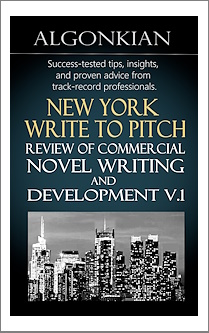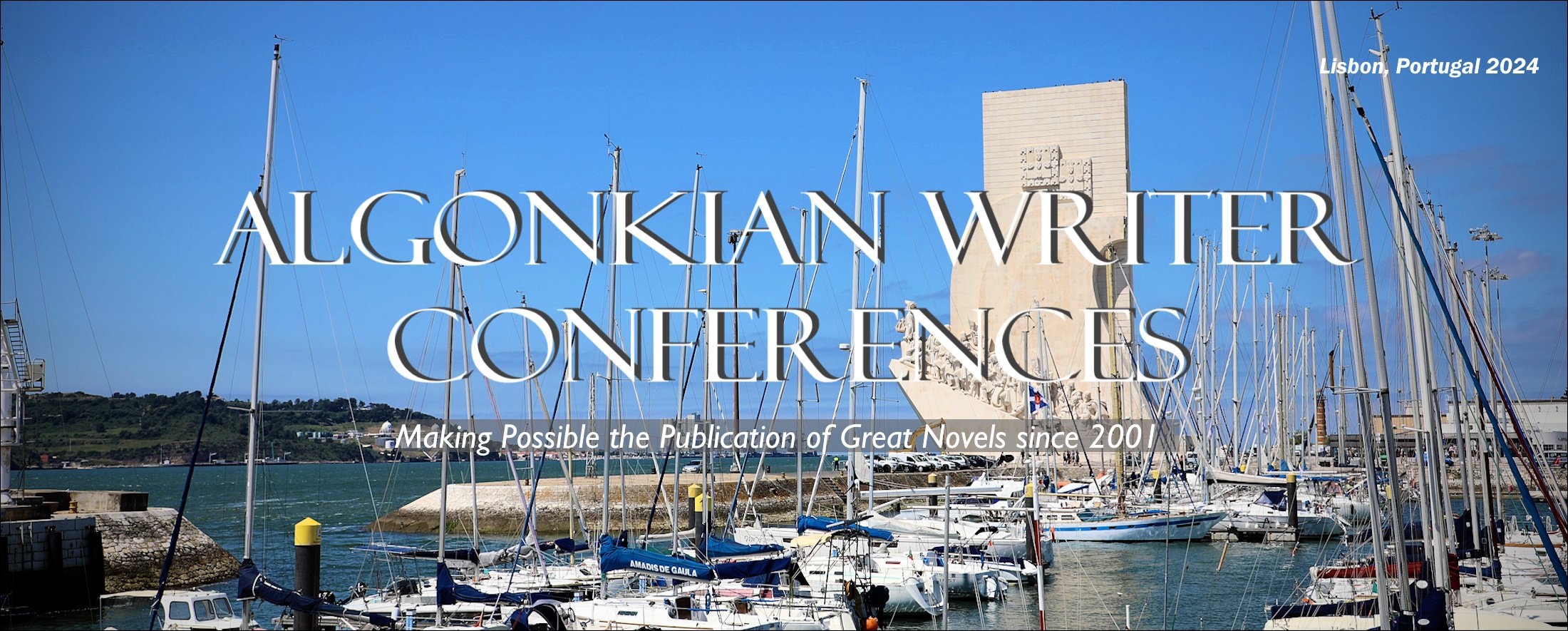Algonkian Writer Conferences - Events, FAQ, Contracts
 Algonkian Writer Conferences nurture intimate, carefully managed environments conducive to practicing the skills and learning the knowledge necessary to approach the development and writing of a competitive commercial or literary novel. Learn more below.
Algonkian Writer Conferences nurture intimate, carefully managed environments conducive to practicing the skills and learning the knowledge necessary to approach the development and writing of a competitive commercial or literary novel. Learn more below.
 Upcoming Events and Programs
Upcoming Events and Programs
 Pre-event - Models, Pub Market, Etc.
Pre-event - Models, Pub Market, Etc.
 Algonkian Conferences - Book Contracts
Algonkian Conferences - Book Contracts
 Algonkian Conferences - Ugly Reviews
Algonkian Conferences - Ugly Reviews
 Algonkian's Eight Prior Steps to Query
Algonkian's Eight Prior Steps to Query
 Why do Passionate Writers Fail?
Why do Passionate Writers Fail?
Subforums
-
- No posts to show
14 topics in this forum
-
- 2 replies
- 5.9k views
Algonkian Writers Conference Programs and Events - Ongoing Queue: Manuscripts to Market Editorial Service - $1500+ (Novels - Most Genres) - Ongoing Admissions: Novel Development and Editorial Program, $299 - Online Courses ___________ - September 19 - 22, 2024 : Write to Pitch 2024, LIVE IN NEW YORK, $895 - (Map/Directions) - September 25 - 29 2024 : Algonkian Workshop Retreat in VA, $1195 - (Map/Directions) - November 6 - 10, 2024 : Monterey Writer Retreat, $1095 - (Map/Directions) - Dec…
 Last reply by Admin_99,
Last reply by Admin_99, -
- 0 replies
- 830 views
The New York Write to Pitch reviews, bullet by bullet, what makes the conference especially valuable to writers in terms of development, craft, and market guidance. See the NYWP e-Book below for an example. "New York Write to Pitch 2023: Development Guideposts and Crucial Craft Prior to Novel Pitching" Amazon Page Free Kindle Reader As noted on Amazon, this is a compilation of important articles, notes, and studies drawn from the conference pre-event schedule. The e-book addresses the vital core points that will be discussed in the context of each writer's novel-in-progress. From relatively simple matters of proper title choice to polished interio…
 Last reply by Admin_99,
Last reply by Admin_99, -
- 2 replies
- 9.5k views
What is the Purpose of Algonkian? To give writers in all genres a realistic chance at becoming published commercial or literary authors by providing them with the professional connections, feedback, advanced craft knowledge and savvy they need to succeed in today's extremely competitive market. What is Your Strategy for Getting Writers Published? - A model-and-context pedagogy that utilizes models of craft taken from great fiction authors and playwrights, thereby enabling the writer to pick and choose the most appropriate techniques for utilization in the context of their own work-in-progress. - Emphasis on providing pragmatic, evidence-ba…
Last reply by DEEJ, -
THE FOLLOWING COLLECTION OF REVIEWS, CONTRACT NEWS, AND GENERAL COMMENTARY INVOLVES ALGONKIAN WRITER CONFERENCE EVENTS OVER THE PAST SEVERAL YEARS. THESE ARE AN ESTIMATED 20-25% OF THE TOTAL MAILS, INTERNET POSTINGS, AND OTHER COMMUNICATIONS SENT TO US. WE APOLOGIZE TO THOSE WHOSE REPORTS AND OBSERVATIONS HAVE NOT BEEN INCLUDED HERE. PLEASE KNOW WE ARE GRATEFUL FOR YOUR COMMUNICATIONS. __________________ I attended an Algonkian Writer Conference event a couple of years ago. It was just what I needed to turn my idea into a published, award-winning book entitled The Mrs. Tabor. No kidding. - Kimberly Coleman Burns Agent Katharine Sa…
 Last reply by EditorAdmin,
Last reply by EditorAdmin, -
- 1 reply
- 11.8k views
About Algonkian Events and Workshops Haste born of impatience is a writer's second worst enemy. Hubris is the worst. - Director Michael Neff Algonkian Writer Conferences began in late 2001 on the banks of the Potomac River at Algonkian Park in northern Virginia. With its beautiful setting and cottages, it seemed a natural place for a workshop, and thus, Algonkian Writer Workshops was born. By 2004 it had expanded to include more professionals in the literary business, i.e., agents, editors, and authors, as well as more events such as the pitch conference in New York. At Algonkian events, we maintain intimate, carefully managed env…
 Last reply by Admin_99,
Last reply by Admin_99, -
- 5 followers
- 40 replies
- 3.9k views
Introduction to Pre-event Assignments The below seven assignments are vital to reaching an understanding of specific and critical core elements that go into the creation of a commercially viable genre novel or narrative non-fiction. Of course, there is more to it than this, as you will see, but here we have a good primer that assures we're literally all on the same page before the event begins. You may return here as many times as you need to edit your topic post (login and click "edit"). Pay special attention to antagonists, setting, conflict and core wound hooks. And btw, quiet novels do not sell. Keep that in mind and be aggressive with your work. …
Last reply by Christine Roy, -
- 1 follower
- 100 replies
- 8.7k views
Below are elements that all would-be narrative fiction artists should consider, regardless of genre - prior to fingers touching the keyboard, and while the fingers are tapping. These elements should be used in this forum for helpful critique as well as writer editorial purposes. Keep in mind, that aside from the notes which follow, a great story premise with a strong plot and excellent characters will keep reader eyes on the page most effectively. All else is extra but necessary recipe - cliché but true. => For those about to post a sample of their prose narrative, this forum will serve you best if you post a three or four page scene taken from your opening …
Last reply by Rima, -
- 4 followers
- 65 replies
- 7.4k views
Introduction to Pre-event Assignments The below seven assignments are vital to reaching an understanding of specific and critical core elements that go into the creation of a commercially viable genre novel or narrative non-fiction. Of course, there is more to it than this, as you will see, but here we have a good primer that assures we're literally all on the same page before the event begins. You may return here as many times as you need to edit your topic post (login and click "edit"). Pay special attention to antagonists, setting, conflict and core wound hooks. And btw, quiet novels do not sell. Keep that in mind and be aggressive with your work. …
Last reply by Lora D., -
- 1 reply
- 2.4k views
Algonkian Writer Conferences reviews two of the most troll-heavy "reviews" ever encountered by its staff, or for that matter, humans still alive in the 21st century. Algonkian Park in Northern Virginia might be described as a lush and calming act of forest rubbing shoulders with the Potomac River, and it was here, twenty-two years ago, that Algonkian Writer Conferences began with a small workshop of five writers. Since then, the grand majority of my own experiences with many hundreds of my fellow writers have been rewarding, and I can truthfully say I've played a productive role in assisting many to secure both agent and publisher contracts. However, dur…
 Last reply by EditorAdmin,
Last reply by EditorAdmin, -
- 1 reply
- 2.5k views
The following are major pre-event assignments, readings, and guides (not including Part IV - Algonkian Novel Development Program) for Algonkian workshops and other events. Downloading, forwarding, or copying these assignments without the prior approval of Algonkian Writer Conferences is not permitted, however, routine utilization of the content in its extant form is permitted. Parts I, II, and II Pre-Event (includes eBook) Execution of the Pitch Model Assignment Recap and Dramatic Act Structure The Necessity of Publisher's Marketplace Prep for Agent Query Process NOTE: this is an information forum, not a response forum. Utilize the …
 Last reply by Admin_99,
Last reply by Admin_99, -
- 1 follower
- 0 replies
- 718 views
Michael Neff is an award-winning author, Pushcart-nominated poet, widely published short fiction writer, literary agent, writer conference organizer, as well as an accomplished developmental editor. His first novel All The Dark We Will Not See was published by the distinguished academic press, Serving House Books. A few years later, an urban fantasy, Magicians Impossible, was created and co-edited by him, and later published by Macmillan Books. His science-fantasy novels, American Oz Maker, and the prequel, World Maker, have both received multiple awards. Michael is also the founder and chief architect of Algonkian Writer Conferences including the famous and highly …
 Last reply by EditorAdmin,
Last reply by EditorAdmin, -
- 0 replies
- 2.5k views
This article covers the common symptoms of new and impatient novel writing. Algonkian Writer Conferences reviews this epidemic condition in a frank and direct manner. 1. NEOPHYTE SKILL SET AND A FAILURE TO COMPREHEND THE PROBLEM In the case of the former, we've found in our reviews that the prose itself fails to display the energy, creativity, suspense and cinema necessary to convince an agent to go deeper. This is perhaps the number one cause of failure, and the reason why veteran readers need not go further than a page or two of the manuscript. Usually, the writer is not aware of this condition--or at least, not sufficientl…
 Last reply by Admin_99,
Last reply by Admin_99, -
- 0 replies
- 909 views
(courtesy of Ted) I. Overview Describe your book in two or three paragraphs (500 words or less). What is the title and subtitle? Who is the target audience and what makes your book unique and worthwhile for them? Think of this as the copy that would go on the back cover of your book or in the publisher’s catalog, or as the brief review that you hope to see in Publishers Weekly or the NY Times Book Review. II. Target Audiences Who is your core audience, the most likely purchasers of this book? How big is that market, and how can they best be reached? What other groups and types of readers will also be interested? III. About the Author Your cre…
 Last reply by Admin_99,
Last reply by Admin_99, -
- 1 reply
- 1.5k views
Deciding to update the current New York Pitch with elements of the "Write to Market" event featured in the San Francisco Bay area, the editors at Algonkian have produced a unique new hybrid conference known as the New York Write to Pitch 2023. So what's actually new? The Write to Pitch includes more formal emphasis on addressing the quality of competitive prose narrative, utilizing various guides and exercises that include the prose "opening pages" guide forum here on Algonkian Author Connect. And btw, what kind of writers will benefit from this new event? Looking for a Reality Check Writers who believe they need a mid-course or early stage reality check to …
 Last reply by EditorAdmin,
Last reply by EditorAdmin,








